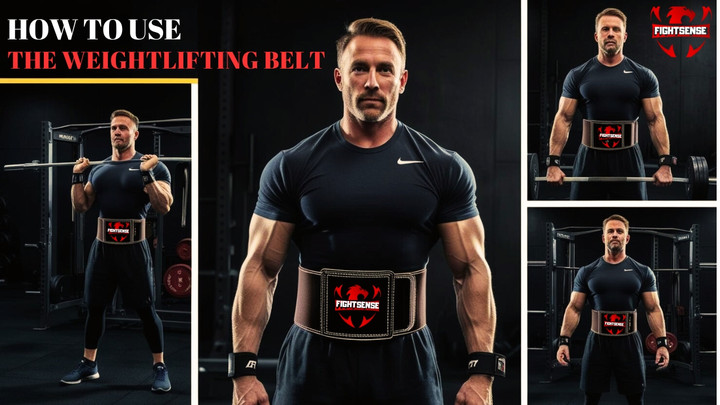How to Use a Weightlifting Belt: A Step-by-Step Guide
16th Mar 2025
A weightlifting belt is more than just a thick leather strap encircled around your waist. When used properly, this excellent instrument improves strength, stability, and general lifting performance. Many lifters, though, use it believing it will miraculously stop injuries. Actually, a belt increases intra-abdominal pressure and strengthens core involvement. Let's go beyond conventional wisdom and explore proper weightlifting belt use.
Key Highlights
-
A weightlifting belt enhances stability and improves lifting performance
-
Proper bracing is essential to maximize belt effectiveness
-
Use the belt strategically for heavy lifts, not for every exercise
-
Position the belt correctly above the hip bones for optimal support
-
Avoid over-reliance on a belt and focus on core strength development
Why Knowledge of Weightlifting Belt Use Matters
Your training might be much improved by proper belt use. Knowing its correct application guarantees superior technique, injury prevention, and improved performance, whether for weightlifting, dips, or general strength training. Using a belt lessens its advantages and may potentially raise the strain or injury risk.
Use Wisely
First step: Find out whether you need a belt.
Ask yourself before strapping one on if you really need it. There is not a belt for every lift or every lifter. A belt will help you greatly if you are doing big compound motions such as squats. deadlifts, or overhead presses with eighty percent or more of your maximum load. On the other hand, if you wear it for every set, including warm-ups, you may be weakening rather than strengthening your core.
Second Step: Select the proper belt.
No two belts are exactly the same. Here is what to search for.
-
Material either robust leather or strong nylon.
-
The width The finest support is given by a homogeneous four-inch breadth.
-
Thanks for the dedicated lifters; ten millimeters to thirteen millimeters is perfect.
-
Type buckles provide more security than Velcro and come from prong or lever buckles.
Third step: Properly position the belt.
Many lifters don their belts either too low or too high. Here is how to get it perfect.
-
Just above your hip bones, cover the midsection you brace your core from with the belt.
-
It should feel tight but not stifling. You need space to develop your core and breathe.
-
Steer clear of overly tightened screws. If you find you unable to inhale deeply, gently relax.
Step Four: Correct Bracing Master
A belt does not make one immediately stronger. It improves bracing technique. The approach is as follows:
-
Breathe deeply through your nose before lifting.
-
Stretch your stomach against the belt. Try not to suck it in
-
Keep that pressure all during the movement.
-
At the top of the lift, exhale under control of tension.
Most lifters fail here by only tightening the belt without using intra-abdominal pressure. The belt is a tool, not a shortcut.
Step Five: Use the Belt Only Where Called For
One cannot substitute a belt for fundamental development. Make use of it deliberately.
-
Wear it for hard sets over eighty percent of one rep max.
-
Try not to use it for every single workout. First, build your natural core strength.
-
Eliminate it between sets to avoid reliance.
How to dip using a weight belt?
For weighted dips, adding resistance, and assisting with strength-building, a weight belt is quite successful. Here is the right approach for taking advantage of it.
-
Get the correct weight belt. Choose a robust belt, including a chain attachment.
-
Fix the weight. Run the chain across a kettlebell or weight plate.
-
Tighten the belt around your waist. Fasten it such that it rests comfortably on your hips.
-
Keep proper form. Use your core to maintain your chest up and execute controlled dips.
-
Take After the Set. Remove the belt between sets to save unwarranted strain.
How Should One Use a Weightlifting Belt for Various Exercises?
For minor belt modifications in technique, different exercises are required.
For deadlifts and squats
-
Sling the belt tightly around the abdomen and lower back.
-
Breathe deeply and brace, then slide down the lift.
-
Keep a neutral spine and work your core all through
For overhead pressers
-
Keep the belt rather looser to provide improved movement.
-
Use it for extra stability, particularly for large weights.
-
Keep good posture and steer clear of too much leaning.
Regarding weighted pull-ups and dips
-
Put the belt around the waist and properly fasten weights.
-
Maintaining proper body alignment helps you avoid too much swinging.
-
Take off the belt straight away after finishing the set.
Typical Mistakes to Stay Away From
-
The belt is worn too loosely. There is no stability from a loose belt.
-
Wearing it too tight can limit mobility and breathing. Limitations on mobility and appropriate breathing
-
Implement it for every lift. Weaknesses in inherent core strength
-
You are ignoring basic instruction. A belt cannot correct obliques or weak abs.
Shop Now!
Thoughts on Final Notes
Correct use of a weightlifting belt will greatly increase safety and performance. The finest outcomes will come from either exercising for strength using your belt correctly or from lifting large, performing dips. Use these rules to prevent common errors and improve your training with correct methods.
Disclaimer
This page serves only for informative needs. See a fitness expert beforehand to guarantee correct technique and avoid damage by using a weightlifting belt.

